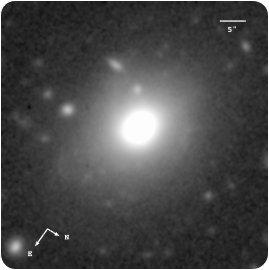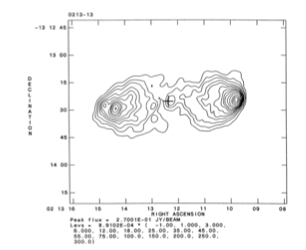






Flux data
Available Data Downloads
Images, Maps, Spectra and SEDs


Infrared data
Radio data
Optical data
X-Ray data


Chandra


Spitzer IRS spectra

PKS0213-13
Spitzer IRS spectra
Dicken et al. (in preperation)


PKS0213-13
Spitzer MIPS infrared photometric observations. Left to right: 24 microns, 70 microns and 160 microns (when available). FOV are 5x5 arcmins for 24 microns, 5x2.5 arcmins for 70 microns and 0.5x5 arcmins for 160 microns.


![Wavelength/
Frequency Flux Units Reference
5GHz 1.8 Jy Morganti et al. (1993)
[OIII] -13.68 Log erg/cm2/s Tadhunter et al. (1993)
15GHz core - mJy Dicken et al. (2008)
22 GHz core - mJy Dicken et al. (2008)
24 microns 40.2 mJy Dicken et al. (2008)
70 microns 37.1 mJy Dicken et al. (2008)
160 microns <51.1 mJy Dicken et al. (2008)
X-ray - - -](PKS0213-13_files/shapeimage_19.png)







Other name:
Redshift:
RA (j2000):
Dec (j2000):
Optical class:
Radio Class:
0.147
02 15 37.5
-12 59 30.5
NLRG
FRII
3C62


N

E


Notes
The Gemini optical image of this NLRG/FRII galaxy reveals a clear system of shells with a surface brightness of μ_V = 24.7 mag arcsec−2 for the brighter shell (∼20 kpc to the north) and 25.1 mag arcsec−2 for the eastern and outer shell (∼27 kpc from the nucleus: Ramos Almeida et al. 2011a). Our long-slit spectrum of this galaxy shows that emission- line contamination is not a serious issue for the shell structure to the NE.
The optical spectrum reveals high ionization emission lines, and the continuum appears typical of early type galaxies.

Gemini/GMOS-S: median filtered image
5 GHz VLA radio map
PKS0213-13
Spectral energy distribution. The blue solid line is fitted to the data from 109 to 1010 Hz. Extrapolating this line from the radio to the infrared SED tests whether non-thermal synchrotron emission from the lobes can contaminate the Spitzer mid-infrared flux. In this case the lobes emission lies out of the Spitzer beam so cannot contaminate the Spitzer data. The weak, flat spectrum, non-thermal radio core emission is also not likely to contaminate the Spitzer infrared flux data for this object.